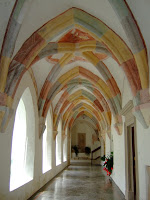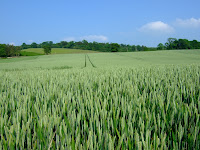
We set out to find the only remaining headquarters of a European resistance movement from WWII. The drive was through an area of forest described as remote and beautiful. The various factions fighting the Nazis, somehow managed to co-exist in this remote spot, and when one reads the list it is amazing what a common enemy can unite: Liberation Front Executive Committee; Supreme Council of the Liberation Front; Communist Party Central Committee; Propaganda and Agitation Commission;

editors of different partisan newspapers and publications; Antifascist Council of Yugoslav National Liberation; The Protection Battalion fighters; as well as Allied advisors.
In spite of diligent searches, the Nazis never found the camp, and we began to wonder if we would either. The tourist map indicated it was about halfway between Kočevje and Podturn. All lies! The road from Kočevje quickly became an unsealed, single-lane, forest track which probably would have been OK had it been adequately sign posted.

It was too late when we realised that the kilometre markers denoting that we were following Route 917 were no longer popping up every 0.5km. Bravely we pressed on and more by good luck than good management rejoined the 917 after making a detour of indeterminate length and duration. After a few more torturous kilometres we eventually found Baza 20 and discovered that the ‘super-highway’ in from the other end was not only sealed and two-lanes wide but hardly any distance. Tip to fellow explorers: Approach from the north!

Twenty-six huts hidden in the forest still survive. There was amazing feeling of history and an understanding of the hardship that the fighters had been through to construct the camp, carrying everything they needed in on foot, kept the location secret, printed propaganda that they then had to carry out on their backs and survived through 3 snowy winters in these unheated huts.

Our second visit of the day also had a real sense of history. We did a tour of the Stična Monastery. Except for the period between 1784, when Joseph II dissolved the monasteries, and 1898, when the monks finally returned, Cistercian monks have lived, worked and prayed here from the time the monastery was founded in 1132, just 34 years after the Cistercian Order was founded in France.

Leaving 780 years of history behind the monastery walls we continued on to Novo Mesto.
As we walked into town, we could hear singing and music: it sounded great, and we expected traditional costumes but although there was some form of local festival in progress the singers were definitely not in local costume – skirts too high and bodices too low!

We were not sure if we were a little early or too late as there were masses of unoccupied chairs and tables set out by the food and wine stalls. Regardless, we relaxed and enjoyed the music as sipped a glass of the local drink: Cviček wine, a low alcohol mixture of red and white wines.
We decided to spend the night at another tourist farm. Last evening the emphasis was on ‘tourist’, tonight the emphasis was definitely on ‘farm’.

Outside the window was the barn where the herd of 10 milk cows, 4 heifers, 4 yearlings and 2 calves was put to bed for the night. The next shed held the rooster and hens, around the corner was the pig and across the road was the duck or goose farm. We looked forward to the prospect of a great night’s sleep!
Today's Slovenian impression: The wonderful variety in the scenery.
 After an 11 a.m. appointment in Birmingham, we threaded our way across Birmingham to the NT property of Moseley Old Hall. There had been heavy thunderstorms during the last two days, so we were glad to be inside on a tour of the house during a downpour.
After an 11 a.m. appointment in Birmingham, we threaded our way across Birmingham to the NT property of Moseley Old Hall. There had been heavy thunderstorms during the last two days, so we were glad to be inside on a tour of the house during a downpour. There was a priest hole he also hid in when the Roundheads came calling. It was during this escape that Charles hid in an oak tree, this episode being the origin of the phrase “Royal Oak”.
There was a priest hole he also hid in when the Roundheads came calling. It was during this escape that Charles hid in an oak tree, this episode being the origin of the phrase “Royal Oak”. which were closed when we visited in April.
which were closed when we visited in April. We decided to risk the weather, and set out on an eight-mile walk. The air was crisp and the views superb. The turning point in the walk was a country church and we listened to the bells pealing as we crossed the fields towards it. The public footpath went through the churchyard and right past the front door.
We decided to risk the weather, and set out on an eight-mile walk. The air was crisp and the views superb. The turning point in the walk was a country church and we listened to the bells pealing as we crossed the fields towards it. The public footpath went through the churchyard and right past the front door.  Ordinarily this is not a problem but we did feel rather out-of-place tromping through the massed wedding guests, them in their finery, us in our shorts and boots.
Ordinarily this is not a problem but we did feel rather out-of-place tromping through the massed wedding guests, them in their finery, us in our shorts and boots.















 Three of the four locks on our journey were against us and the river was still running at higher than normal flow so we were half an hour late returning the boat, but the hire people kindly did not charge us extra.
Three of the four locks on our journey were against us and the river was still running at higher than normal flow so we were half an hour late returning the boat, but the hire people kindly did not charge us extra.  Given the queue of people standing in the boatyard, the hire people were probably overjoyed to have the boat back to satisfy another customer.
Given the queue of people standing in the boatyard, the hire people were probably overjoyed to have the boat back to satisfy another customer.



























